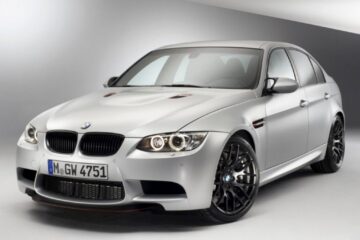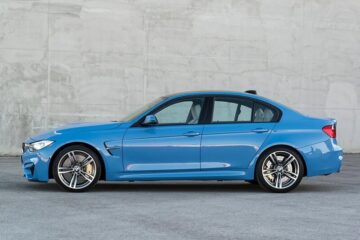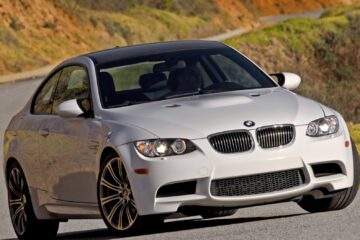The previous generation of the M3 series in the E30 body set the bar high in the sports car segment for public use. Therefore, the engineers faced certain problems when deciding on a generation change. Using old motors and outdated technologies was an excluded option, as it was necessary to make the successor several times better than the predecessor.
And so, in 1993, the BMW M3 E36 car appeared on the market, which was designed on the basis of the classic E36 model. But at a certain look, it was possible to note a huge number of changes in the exterior. The front dodger turned out to be more developed, there was also a dodger at the back, the arches became expanded much more, and the side mirrors received a more streamlined shape. The suspension has also been slightly lowered, and there are a huge number of other changes that are noticeable at first glance.
There were several body versions of the model, among which you could find the usual for the previous model coupe and cabriolet with a soft folding top, characterized by a greater mass, so it develops lower speed. An innovation for the Bavarians was the introduction of a sedan body.
The technical aspects of the M3 involved the practical absence of components from the regular E36 version. If we look in more detail, we can see that there is almost nothing in common, and the sports version is in fact a different car.
Spring view
The front bumper is the first thing that catches your eye when you look at the BMW M3 E36 sedan. The main distinguishing feature is that it has special holes, which are not only aimed at improving the appearance, but also have a much more important function – they supply air for blowing the brake disks. Such a decision is not superfluous, given the fact that this is primarily a sports car.
On the side moldings of the car there was the usual mark in the form of the letter M, also the designation was present on the trunk lid, thanks to which the car easily stood out in the general flow. Also on the M3 series there were special mirrors, which differed from the details installed on the usual models. The sills were also a distinctive feature.
The factory tire size on the M3 E64 was 17 inches in diameter, and the width of the front wheels was 225 millimeters and the rear wheels were 224 millimeters. The length of the car body in coupe, sedan and cabriolet versions was 4432 millimeters, with a wheelbase of 2700 millimeters. The sedan was distinguished by a greater height, which was 1366 millimeters. The height of coupe cars was 1336 millimeters with a width of 1796 millimeters for all body versions. The first versions, which provided installation of the power unit S50B30, had a curb weight of 1420 kilograms. On later models of the car could be found under the hood motor S50B32, which added to the total weight of 40 kilograms.
The design department made a conscious decision to abandon the very wide wheel arches and place an oversized rear spoiler. This allowed the car to gain new market positions.
All exterior elements were characterized by aerodynamic design, which gave the model an aggressive and sporty appearance, as well as positively affected its dynamics. The rear bumper was quite massive and a large exhaust system was installed on it, which immediately attracted attention. It is difficult to leave without attention and special wheel rims, as well as overlays.
Interior
Studying various sources, one can come to the conclusion that many good words have been said about the saloons in the Bavarians’ cars. A typical brief consideration is the unfolded panel, a sufficient amount of space for comfortable seating in front, and the inconvenience of placing rear passengers in the cabin of the BMW M3 E36. The size of the trunk deserves special attention, which in the coupe body version is 405 liters, which is quite a lot for a sporty modification of the car.
Despite the fact that the BMW concern developed the new generation of the M3 model as one of the cars for successful participation in body races, the everyday use of such a modification was also not neglected. Engineers and designers managed to combine excellent dynamics with the convenience of constant use. As a result, it brought a lot of positive emotions while driving such a car.
The previous M3 E30 was characterized by a very cramped seating position for rear passengers. In this generation, the engineers have made every effort to get rid of the typical problem, and they have succeeded – there is enough space in the new M3 E36 coupe for both front and rear passengers.
By releasing a sedan with four doors, the manufacturers managed to fulfill the desire of many buyers who simply dreamed of reuniting a luxury compact car with the high performance of sports models. The quality of everyday driving combined with sporty performance became the most successful solution from the German company. The interior began to correspond to the representative class of cars from the Bavarians – in the M3 E36 began to install wooden decorative inserts and leather seats, developed together with the company Nappa.
Considering all these qualities, the fact that the M3 E36 has become one of the most popular models of its years is justified and understandable. The company has received a huge number of titles and awards, and debuted at a huge number of exhibitions precisely thanks to the production of this generation of the M3 series.
Motors
Under the hood of the BMW M3 E36 places under itself a real work of art from the world of racing cars. On the first modifications, intended for delivery to the European automobile market, installed power units S50B30. These are three-liter engines 3.0 mt, which many followers of the company immediately noticed based on the markings. The factory version of this motor provided for the installation of an individual throttle intake for each cylinder. This, in combination with well-designed exhaust, boring and quality polishing of the cylinder head channels allowed the inline six-cylinder engine to gain speed very well.
Technical characteristics of BMW M3 E36 are as follows: the maximum performance of this power unit is 286 horsepower, with a peak torque of 320 Nm. The car with such a motor under the hood accelerates to the first hundred in 6 seconds. Thanks to the installation of front disc brakes front and rear it was possible to achieve the time of full stop from a hundred kilometers per hour in just 2.8 seconds.
Later versions had the M3 E36 S50B32 engine. The working volume of this motor was 3.2 liters. To achieve this figure, engineers took as a basis the cylinder block from the previous engine and installed a crankshaft with a stroke of 9.1 centimeters. The diameter of the cylinders became 86.4 millimeters. For additional power, a decision was made to use graphite-coated connecting rods and install lightweight pistons, providing a compression ratio of 11.3.
The engine’s cylinder head has also been modified. The S50B32 was the first BMW power unit to feature the Double-VANOS system, which provides continuously variable valve timing on both intake and exhaust shafts. Modernization touched and valves intake mechanisms increased to 35 millimeters, and the thickness of the rod became smaller – instead of 7 it became 6 millimeters. The dual-mass flywheel and exhaust system have also been upgraded. The intake mechanism received an increased diameter and reduced length. The electronic control unit used on such engines is Siemens MSS50.
Thanks to such innovations, the characteristics of the BMW E36 M3 made it possible to realize that the city serial engine overcame the unattainable at that time bar of 100 horsepower per liter of working volume. And all this without the use of superchargers – the motor remained atmospheric. Power output of the S50B32 was 321 horsepower, and maximum torque was 350 Nm.
These motors are not without typical faults, just like all powertrains from the German manufacturer. Both of these engines often succumb to overheating. The consequences of such a problem can be most unpredictable. In case an increased temperature of the power unit was noticed, it is necessary to check the condition of the pump, thermostat and radiator. Often such malfunctions can be caused by the occurrence of air plugs in the cooling system or a breakdown of the radiator cap.
While the engine is running, one of the cylinders may fail. There may be several causes of this problem, but the most common cause is ignition coils. Less frequently, the injectors or plugs may fail.
The engine can cause problems with floating revolutions. This is usually caused by a broken idle valve. You can try to get rid of the problem by cleaning the node. If the malfunction could not be eliminated, then it is necessary to clean the throttle flap. If this does not help, it is worth paying attention to the lambda probe, temperature sensor and throttle position sensor.
The VANOS system also often causes problems for owners of vehicles with these motors. Symptoms may include floating revs, loss of power or external noises during operation. The repair kit will help to eliminate the malfunction.
Increased oil consumption is also very common in these vehicles. The motor can consume up to 1 liter of lubricant per thousand kilometers. After an engine overhaul, the problem often remains. The cause may be the formation of leaks in the valve cover or sump. Often oil can also leak out through the dipstick itself. Cracks in the expansion tank are also quite common, resulting in coolant leaks. Due to their age, problems can occur with the camshaft and crankshaft position sensors.
Despite all these typical faults, this power unit is considered one of the most reliable motors produced by the German concern. Most of the problems are caused due to the high age and heavy loads to which car owners subject the motors. Even with hard operation, the resource of engines can reach 400 thousand kilometers, and with timely oil changes and the use of quality fuel, this figure can be increased.
Options
As standard, the BMW M3 E36 included the installation of very powerful brakes. This is a sports car, so it is logical that it has swivel-disc brake calipers with a ventilation system on all four wheels. At that time, in every car of the German concern, ABS brake technology could be found, but for installation on this modification it was specially finalized, which allowed it to improve the performance of the machine.
The M3 Cabriolet, which provided seating for four passengers and was first presented to the world in 1994, also featured certain options as standard. First of all, it was the innovative rollover protection technology. This was a kind of revolution from the Bavarians, which offered all passengers protection never before fitted to cars with rollover protection.
In the event of a rollover, optimum protection for driver and passengers was ensured thanks to a very rigid frame on the windshield, as well as two arcs mounted behind the rear headrests of the seats, which were out of sight. The model also features vehicle position sensors that conduct instant activation of the arcs by means of springs to ensure extreme strength.
In 1197, a non-standard solution was offered for the E36 in the M3 version – an automated manual gearbox SMG. The same year was also marked by a small restyling of the model, which brought the installation of turn signals covered with white glass. The three-liter engine was also replaced by the 3.2-liter engine mentioned above.
Special modifications
There were a lot of special models that were assembled by the Bavarians using the M3 E36 as a basis: M3 E36 GT, M3 GT Individual, M3 LTW, M3-R, M3 GTR E36, M3 Evolution, Special Edition Coupe, Special Edition Cabriolet, DTM and Luxury Package.
Only in 1999 the production of Anniversary Edition was started. In the collection of BMW Art Cars you can also find a single copy of the special Art Car Sandro Chia, which was assembled in Australia. The M3 Compact E36 is also an exclusive car that was produced in a single copy.
In 1999, the production of BMW M3 E36 was stopped. In total, more than 71 thousand cars were produced in the period from 1994 to 1998. The coupe and convertible body found a replacement in the form of the next generation M3 E46, the sedan replacement appeared only with the release of the M3 E90.
Generations and equipment
Sedan 2nd generation
07.1994 – 04.1999
| 3.0 MT | S50B30 | 3.0l | 286 hp |
| 3.0 MT GT | S50B30 | 3.0L | 295 hp |
| 3.2 MT | S50B32 | 3.2L | 321 hp |
Convertible 2nd generation
01.1994 – 04.1999
| 3.0 MT | S50B30 | 3.0l | 286 hp |
| 3.0 MT GT | S50B30 | 3.0L | 295 hp |
| 3.2 MT | S50B32 | 3.2L | 321 hp |
Coupe 2nd generation
02.1992 – 04.1999
| 3.0 MT | S50B30 | 3.0l | 286 hp |
| 3.0 MT GT | S50B30 | 3.0L | 295 hp |
| 3.2 MT | S50B32 | 3.2L | 321 hp |



0 Comments